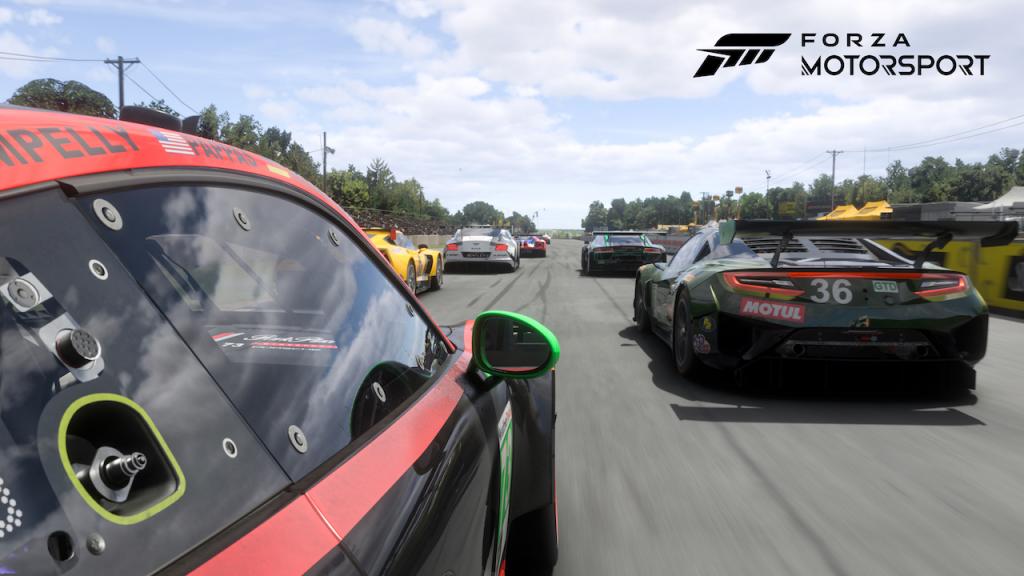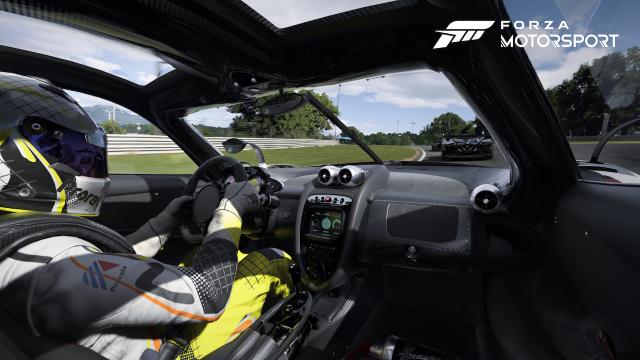There are many important frontiers in video game accessibility, and blind accessibility is right up there. Video games are a very visual medium. There aren’t many developers willing to think outside the box and devise true assists for vision impairment beyond filters for colour blindness. That’s why the blind accessibility mode in Forza Motorsport is so exciting.
Of all the games in all the land, a racing sim is not the first that comes to mind when you think of games that could be played without seeing what’s going on. Racing at high speed, by definition, requires extremely fast reflexes. So, how do you even go about designing a mode such as this? I asked Dan Greenawalt, General Manager of Forza Motorsport and Chris Esaki, Creative Director of Forza Motorsport, about it at a recent event for the game in LA.
Many people who are blind or have low vision have never driven a real car at all. So, before even starting to design these features, it was important for Turn 10 to actually ask the people they were designing the mode for if it was something that they would want.
“As an Xbox first-party developer, we can gain access to those people to say, ‘Let’s just sit down and ideate – would this even be interesting to you? Would you like to drive a game, if you could?’ and we got these amazing responses like, ‘I’ve never driven a car! Of course that would be amazing if I could drive racing games! They’re not even a thing.’ And that really, even to me now, was really touching. To know that people have never had that experience at all,” Greenawalt said.

I’ve interviewed Greenawalt quite a few times since I first met him 12 years ago. The thing that always comes across from him is his passion for introducing people to cars and racing. He loves it so much, and he wants other people to love it too. But even knowing his passion, it was surprising and moving to watch him tear up as he talked about people with vision impairments speaking of their excitement about driving for the first time. The experience was clearly hugely emotional for the whole team.
Once they knew that driving games were something that the community would be into, the next step was for the development team to work out which cues needed to have sounds tied to them, and then do a ridiculous amount of maths to actually make it work.
“It was years in the making to support that one feature, and it is true what they say about how you start building a feature for accessibility, and it starts being usable by everyone,” Esaki said. “I’ve seen what we’ve gotten from investing in our blind driving assistance. It’s a whole list of different features. It’s not just, ‘Oh, it’s a thing that’s on or off’. It’s a suite of audio features that even some of our drivers that are well-sighted in the studio are turning on because they help them get around the track even better.”
In the end, the team came up with a layered approach to the feature. There’s the usual screen narrator, audio descriptions and colour-blind filters. But on top of that, the dedicated blind driving assists include car-to-car collisions (toggle on/off), steering guides broken into different sections for volume adjustment (including tire and player engine volumes), turn navigations (like if JARVIS was into rally cars), turn cues, AI takeover cues, deceleration cues, track limit cues, gear indicator cues, shift up cues, shift down cues, and wrong way cues. The majority of those cues can have their volume and pitch adjusted to better suit the player’s needs.

Post-launch, the reactions to the feature have been largely positive, with many accessibility reviews praising the blind driving assists.
While everything about blind driving assists should absolutely be applauded, I must admit to being a bit disappointed that Turn 10 didn’t include the sign language features that were rolled out to Forza Horizon 5 with so much fanfare. It seems odd for a company like Microsoft to fund such cutting-edge accessibility advancements and then not leverage them for every first-party game. In my opinion, accessibility should be a “yes, and” situation, where each advancement is utilised in each new game, a pool of options for every studio to add to and benefit from, rather than picking an impairment and then leaving out what went before.
Leaving sign language out of Forza Motorsport makes me concerned that blind driving assists will also be a thing just in Motorsport, and not make the jump over to the inevitable Horizon 6.
There’s often an argument that there shouldn’t be assists or easy modes in games, because it somehow reduces competitiveness. Those arguments are usually made by people who don’t remember that there was once a time before they got gud and needed to learn how to play. (Or, more often, by people who straight up suck at games and need someone they feel they can punch down on to just to feel better about themselves, rather than becoming an active, contributing member of their community for a sense of purpose.)
These are also arguments made by people who forget that they are just an infection, accident, or (if they’re lucky enough) birthday away from having accessibility needs. They forget that not having a disability isn’t a sign of moral purity or that they’ve done something right, but simply that they’ve been lucky, or that their genetics didn’t end up going that way. Yet.
Esaki agrees with that, and also says that whether or not you use assists, that still probably won’t make you as good as the pros. “All of the assists that we have in the game, all the accessibility that we have in the game isn’t going to change whether or not you are that fast or have that skill. It just allows you to unlock your fastest self,” he said.
“We’re inviting you to this journey to find out how to be your fastest self. So, whether you use assists or not, that is all there to help you get to that point, where you’re able to be as fast as you can. So yeah, that’s approachability, and that is accessibility.”

The other thing is that a rising tide lifts all boats. There are lots of accessibility features that were designed for one purpose and ended up having unintended benefits for other people. A good example that’s always trotted out for this is curb cut-outs. These were first introduced for wheelchair users, but also benefit people who may be limping or have trouble navigating stairs. They’re also useful to people with prams or shopping trolleys, and kids on skateboards. There’s the movement of gluten-free diets proved beneficial for people with coeliac disease and wheat allergies because it made food they could consume more accessible. Subtitles are great for people who are hearing impaired, but also for people consuming content not in their first language, people watching on mute, and those subjected to the world’s worst audio mixing on Netflix.
There is almost never any downside to a well-designed accessibility feature, particularly not in a game.
Forza Motorsport is available now.
Alice Clarke travelled to Los Angeles as a guest of Microsoft.

Leave a Reply